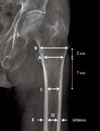Abstract
Purpose
The purpose of this study is to analyze the clinical and radiographic results of treatment of unstable pertrochanteric hip fractures in which the fracture line is extended distally or the width of the canal is wide using a long intramedullary nail.
Materials and Methods
From January 2005 to January 2010, we conducted an analysis of 20 cases of unstable pertrochanteric hip fractures (over AO/OTA 31 A2.2) treated using a long intramedullary nailing and followed up for more than 12 months. Using postoperative and last follow-up radiographs, we measured TAD, Cleveland index, neck-shaft angle, sliding length of the lag screw, and union time. Clinically, we measured the operation time, the amount of transfusion, and Parker and Palmer's mobility score.
Results
The mean bony union time was 16.4 weeks(10-21 weeks). The mean sliding length of the lag screw was 4.3 mm(1-10 mm) and the mean varus angulation after surgery was 5.1°(3-8°). The mean operative time was 118 min(60-140 min), and the mean transfusion amount was 2.0 pint(0-4 pint). According to Parker and Palmer's mobility score, mean preoperative score was 7.5 points and mean postoperative score at last follow-up was 6.9 points.
Conclusion
In treatment of unstable pertrochanteric hip fractures, when the fracture line was extended to below the lesser trochanteric level or the medullary canal width was wide, use of a long intramedullary nail showed excellent clinical and radiologic results and can be regarded as a good treatment option.
Figures and Tables
 | Fig. 1(A) Canal diameter at lesser trochanter level. (B) Canal diameter at 2 cm above lesser trochanter. (C) Canal diameter at 7 cm below lesser trochanter. (D) Cortex diameter at isthmus. (E) Canal diameter at isthmus. Cortical index (CI) equals the ratio of the femoral diaphyseal diameter minus the intramedullary canal diameter over the femoral diaphyseal diameter: isthmus CI=(D-E)/D. |
References
1. Al-yassari G, Langstaff RJ, Jones JW, Al-Lami M. The AO/ASIF proximal femoral nail (PFN) for the treatment of unstable trochanteric femoral fracture. Injury. 2002. 33:395–399.

2. Anglen JO, Weinstein JN. Nail or plate fixation of intertrochanteric hip fractures: changing pattern of practice. A review of the American Board of Orthopaedic Surgery Database. J Bone Joint Surg Am. 2008. 90:700–707.

3. Clawson DK. Trochanteric fractures treated by the sliding screw plate fixation method. J Trauma. 1964. 4:737–752.

4. Schumpelick W, Jantzen PM. A new principle in the operative treatment of trochanteric fractures of the femur. J Bone Joint Surg Am. 1955. 37-A:693–698.

5. Maniscalo P, Rivera F, D'Ascola J, Del Vecchio EO. Failure of intertrochanteric nailing due to distal nail jamming. J Orthop Traumatol. [Epub ahead of print].
6. Cleveland M, Bosworth DM, Thompson FR, Wilson HJ Jr, Ishizuka T. A ten-year analysis of intertrochanteric fractures of the femur. J Bone Joint Surg Am. 1959. 41-A:1399–1408.

7. Shin DK, Kwun KW, Kim SK, Lee SW, Choi CH, Kim KM. Proximal femoral nail (PFN) for femur intertrochanteric fracture. J Korean Soc Fract. 2002. 15:328–335.

8. Banan H, Al-Sabti A, Jimulia T, Hart AJ. The treatment of unstable, extracapsular hip fractures with the AO/ASIF proximal femoral nail (PFN)--our first 60 cases. Injury. 2002. 33:401–405.

9. Ko SB, Cho MR, Kim TH, Chang IW. Nailing in the patients with intertrochanteric fractures of the femur: comparision gamma nail and proximal femoral nail. J Korean Fract Soc. 2004. 17:295–300.

10. Bess RJ, Jolly SA. Comparison of compression hip screw and gamma nail for treatment of peritrochanteric fractures. J South Orthop Assoc. 1997. 6:173–179.
11. Crawford CH, Malkani AL, Cordray S, Roberts CS, Sligar W. The trochanteric nail versus the sliding hip screw for intertrochanteric hip fractures: a review of 93 cases. J Trauma. 2006. 60:325–328. discussion 328-9.

12. Kang JS, Park SR, Kim HS, Lee WH, Kim KW, Lee JH. Treatment of intertrochanteric fracture with dynamic hip screw and gamma nail: a retrospective matched pair study. J Korean Orthop Assoc. 2001. 36:423–428.

13. Kwak KD, Ko CU, Ahn SM, Ahn KB. Choice of internal fixatives for the intertrochanteric fractures of the femur in the elderly. J Korean Fract Soc. 2005. 18:385–390.

14. Lee SH, Rha JD, Parke HS, et al. Treatment of OTA type A2 intertrochanteric fractures of the femur using sliding hip screw: an analysis of risk factors. J Korean Hip Soc. 2006. 18:479–486.

15. Sohn OJ, Kim SD, Kim IW, Byun SJ. A comparative study of trochanteric fractures treated with the intertrochanteric/ subtrochanteric fixation or the proximal femoral nail. J Korean Fract Soc. 2006. 19:303–308.

16. Hamilton RJ, Kelly IG. Evaluation of the long intra-medullary hip screw. Injury. 2004. 35:1264–1269.

17. Buhl K, du Bois YD, Lamadé W, Meeder PJ. The long gamma nail--indications, technique and results. Chirurg. 2000. 71:1107–1114.
18. Lee SY, Park IH, Song KW, Shin SI, Lee JY, Cha JH. The result of proximal femoral nailing (PFN®) for unstable femoral peritrochanteric fracture. J Korean Soc Fract. 2003. 16:143–147.

19. Hong KD, Sim JC, Ha SS, Kim TH, Choi YH, Kim JH. Operative treatment with gamma 3 nail in femur intertrochanteric fracture. J Korean Fract Soc. 2011. 24:7–15.





 PDF
PDF ePub
ePub Citation
Citation Print
Print




 XML Download
XML Download